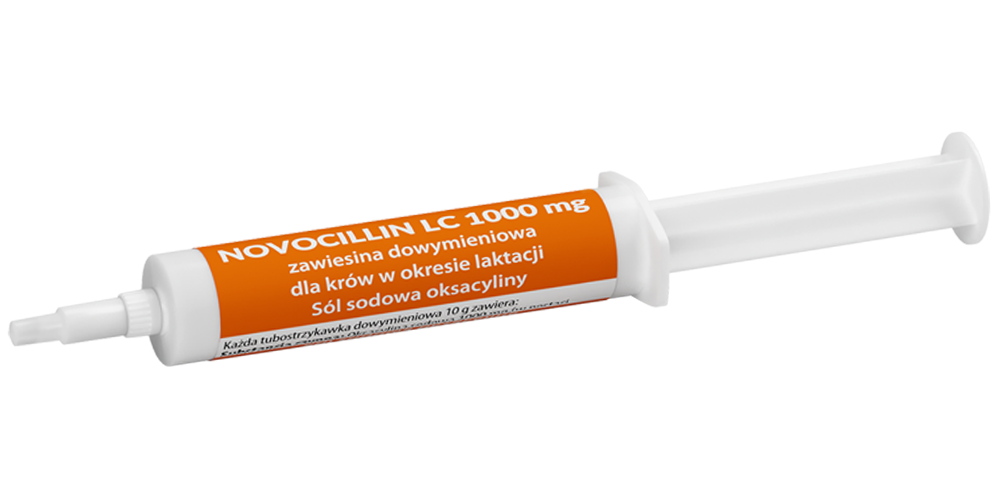NOVOCILLIN LC
Intramammary suspension for lactating cows
Active substance: Oxacillin sodium 1000 mg (equivalent to 1042.5 mg Oxacillin sodium monohydrate or 948 mg oxacillin)
Species:
Package:
Intramammary syringe containing 10 g suspension

Intramammary suspension for lactating cows
Active substance: Oxacillin sodium 1000 mg (equivalent to 1042.5 mg Oxacillin sodium monohydrate or 948 mg oxacillin)
Species:
Package:
Intramammary syringe containing 10 g suspension

For intramammary use.
Immediately prior to the individual treatment, all udder quarters should be milked out carefully. The teat tip should be cleaned and disinfected, followed by intramammary administration of the content from one intramammary syringe per affected udder quarter.
If no significant improvement of the clinical condition is observed within 2 days of treatment, the diagnosis should be reviewed.
Shake the product before use.
Meat and offal – 6 days
Milk – 144 hours (6 days)
Do not use in cases of hypersensitivity to the active substance, penicillin, cephalosporin or to any of the excipients. Do not use in cases of resistance to isoxazolyl penicillins and cephalosporins.
None.
Special precautions for use in animals:
In the case of severe swelling of the udder quarter, obstructive swelling of the milk duct and/or obstruction of the milk ducts by cell detritus, the veterinary medicinal product must be administered with caution to avoid pain and injuries of the teat canal. Use of the product should be based on identification and susceptibility testing of the target pathogens. If this is not possible, therapy should be based on epidemiological information and knowledge of susceptibility of the target bacteria at farm level, or at local/regional level. Use of the product deviating from the instructions given in the SPC may increase the prevalence of bacteria resistant to oxacillin and may decrease the effectiveness of the treatment. Use of the product should be in accordance with official, national and regional antimicrobial policies. The feeding of waste milk containing residues of oxacillin to calves should be avoided up to the end of the milk withdrawal period (except during the colostral phase), because it could select antimicrobial-resistant bacteria within the intestinal microbiota of the calf and increase the faecal shedding of these bacteria.
Special precautions to be taken by the person administering the veterinary medicinal product to animals:
Penicillins and cephalosporins may cause hypersensitivity (allergy) following injection, inhalation, ingestion or skin contact. Hypersensitivity to penicillin may lead to cross reactions to cephalosporins and vice versa. Allergic reactions to these substances may
occasionally be serious. Do not handle this product if you know you are sensitised to penicillins or cephalosporins or if you have been advised not to work with such preparations. Handle this product with great care to avoid exposure by accidental contact with the skin or eyes. Persons developing a reaction after contact with the product should avoid handling the product (and other penicillin and cephalosporin containing products) in future. It is recommended to wear gloves when handling or administering the product. Wash exposed skin after use. In case of any eye contact, wash the eyes thoroughly with copious amounts of clean running water. If you develop symptoms following exposure such as skin rash, you should seek medical advice and show the doctor this warning. Swelling of the face, lips or eyes or difficulty with breathing are more serious symptoms and require urgent medical attention. Wash hands after use.
Hypersensitivity reactions (i.e., allergic skin reactions, anaphylaxis) have been reported very rarely in spontaneous reports. If such a reaction occurs, the current treatment should be stopped immediately and an appropriate symptomatic treatment be initiated.
In case of anaphylaxis: adrenaline (epinephrine) and glucocorticoids i.v.
In case of allergic skin reactions: antihistamines and/or glucocorticoids.
The frequency of adverse reactions is defined using the following convention:
Marketing authorisation holder:
Vet-Agro Multi-Trade Company sp. z o.o.
Gliniana 32, 20-616 Lublin, Poland